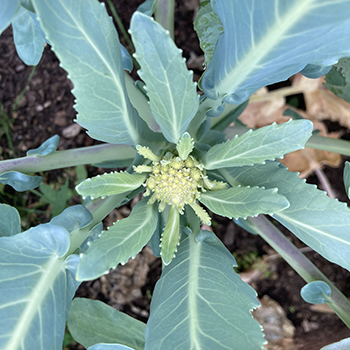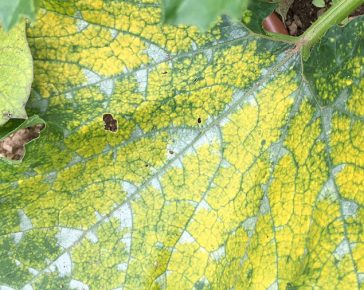With the recent heatwave, cool-loving brassicas may need a little bit of extra care. This article looks at a few different things, from discoloured leaves and caterpillar damage, to cabbage splitting and unformed cauliflower heads.

Caterpillar, Slug & Snail Damage
Brassicas are hugely popular with caterpillars – the cabbage white butterfly lays its eggs on brassica leaves, and when they hatch the caterpillars quickly eat their way through the plant. Check for eggs and caterpillars regularly (at least twice a week) over the next couple of months until the season comes to an end. Remove any you find.
Meanwhile, keep plants well protected from slugs and snails, especially when we start to move into the wetter autumn season.

Remove the dead, yellow leaves
The older, yellow leaves that drop off brassica plants are perfectly natural and nothing to be worried about. They are also very attractive to slugs and snails, so we’d recommend clearing them up and moving them to your compost pile to keep plants in a more healthy state!

Check for nutrient deficiency
Common indications of nutrient deficiency in brassicas are purple-rimmed leaves and pale, slightly yellow leaves (very different to the old, bright yellow leaves that naturally die off.) If you see these, it’s most likely that the plants simply don’t have access to the nutrients in the soil because the soil is too dry. A thorough watering a few times in a week should sort them out. If it doesn’t, a liquid feed is a good idea or mulch with fresh compost.

Keep an eye out for signs of splitting
You may see cabbage hearts suddenly cracking and splitting. Splitting happens most commonly once the cabbage has more or less reached full maturity, and usually begins after a heavy rainfall following a dry spell. The cabbage essentially draws up too much moisture and grows too fast, causing the splitting. If you do see splitting, it’s best to harvest them as soon as you can, before they start to decompose.

Check heads are forming
If you planted back in spring, we’d expect you to start seeing cabbage heads, cauliflowers and romanesco beginning to form in late summer and early autumn. If they don’t, it is most likely due to the very hot weather (brassicas prefer cooler conditions). One thing you may see, for example, is cauliflower forming florets like a sprouting broccoli. You can still use the plants if they don’t form as expected – loose inner cabbage leaves can be harvested and used, and cauliflower ‘florets’ can also be picked (quite good for adding to stir fries)

Wilting may be a sign of cabbage root fly
These flies are attracted to all brassicas and will lay their eggs at the base of brassica plants. When the eggs hatch the larvae bury into the soil and feed on the roots of the brassica plants (as seen in the photo here). As they eat the roots, the plants start to struggle. Growth will slow right down and eventually the plant will wilt and die. There’s nothing you can really do to fix it, and worst of all, the pupae can overwinter ready to hatch out the following spring, which makes growing brassicas a bit tricky (if your crops suffered, then it is a very good idea to rotate crops next year and grow brassicas in a different part of the plot).
Prevention is the way forwards, and we would always recommend putting a brassica collar around the base of plants when you plant them out, ideally covering the row with horticultural fleece as well.




